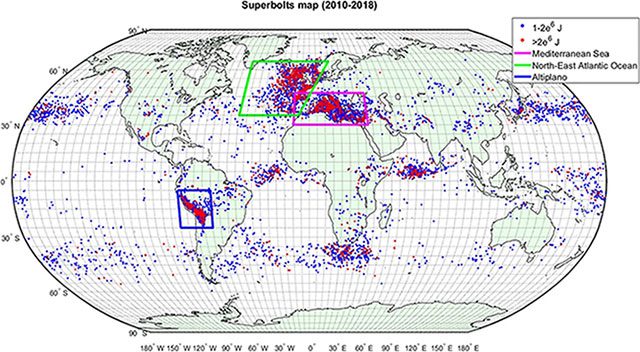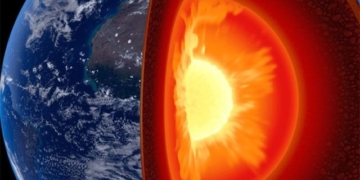Super Lightning: A Rare but Terrifying Phenomenon Research reveals why these electric shocks possess energy thousands of times greater than regular lightning strikes.
Researchers from the University of Jerusalem, Israel, and the University of Washington, USA, analyzed global lightning data from 2010 to 2018 and discovered that the closer the charge region of a thunderstorm cloud is to the ground or sea surface, the higher the likelihood of super lightning occurrences. This charged region is located at the top of the cloud where electrification processes take place.

Scientists have mapped lightning strikes around the world (Photo: Journal of Geophysical Research Atmospheres).
These findings align with previous research that identified the northeastern Atlantic Ocean, the Mediterranean Sea, and the Altiplano plateau in Peru and Bolivia as regions with the highest frequency of lightning strikes. In these areas, the distance between the charge region and the cold sea surface or high mountain peaks is notably short.
This phenomenon is explained by the fact that the charge region is situated above temperatures of 0 degrees Celsius. The cold air over the sea brings the 0-degree Celsius level closer to the surface, while higher mountains force the air to rise more, causing it to cool and lowering the 0-degree Celsius level closer to the surface.
A shorter distance means lower resistance, resulting in a stronger current and thus a more powerful lightning strike.

Illustration showing the elements of a thunderstorm cloud (Photo: Journal of Geophysical Research Atmospheres).
The researchers noted a clear correlation appearing in three distinct areas. This is a valuable discovery. They mapped data on the causes of lightning with varying intensities, including: elevation of land and water surfaces, height of the charge region, temperature at various cloud formation levels, and concentration of aerosols (tiny particles) within the clouds.
While prior studies have considered these relationships, none have compiled them into a global picture like this one. Unlike previous research, this study did not find a connection between super lightning and the mixing of aerosols such as desert dust.
When these super lightning strikes hit the Earth’s surface, they can cause catastrophic damage to buildings and vessels. These new findings will help identify locations prone to lightning strikes.
Additionally, there is a related issue concerning climate change. Scientists need to investigate whether global warming will lead to more or fewer super lightning events and how temperature and humidity changes play a role.
To answer these questions, further studies are required, and researchers continue to explore factors that may influence the formation of super lightning, including variations in the solar cycle and Earth’s magnetic field.




















































